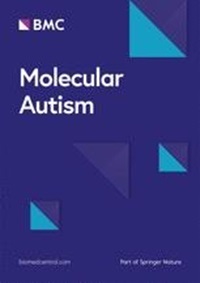Clinical correlates of diagnostic certainty in children and youths with Autistic Disorder
IF 6.3
1区 医学
Q1 GENETICS & HEREDITY
引用次数: 0
Abstract
Clinicians diagnosing autism rely on diagnostic criteria and instruments in combination with an implicit knowledge based on clinical expertise of the specific signs and presentations associated with the condition. This implicit knowledge influences how diagnostic criteria are interpreted, but it cannot be directly observed. Instead, insight into clinicians’ understanding of autism can be gained by investigating their diagnostic certainty. Modest correlations between the certainty of an autism diagnosis and symptom load have been previously reported. Here, we investigated the associations of diagnostic certainty with specific items of the ADOS as well as other clinical features including head circumference. Phenotypic data from the Simons Simplex Collection was used to investigate clinical correlates of diagnostic certainty in individuals diagnosed with Autistic Disorder (n = 1511, age 4 to 18 years). Participants were stratified by the ADOS module used to evaluate them. We investigated how diagnostic certainty was associated with total ADOS scores, age, and ADOS module. We calculated the odds-ratios of being diagnosed with the highest possible certainty given the presence or absence of different signs during the ADOS evaluation. Associations between diagnostic certainty and other cognitive and clinical variables were also assessed. In each ADOS module, some items showed a larger association with diagnostic certainty than others. Head circumference was significantly higher for individuals with the highest certainty rating across all three ADOS modules. In turn, head circumference was positively correlated with some of the ADOS items that were associated with diagnostic certainty, and was negatively correlated with verbal/nonverbal IQ ratio among those assessed with ADOS module 2. The investigated cohort was heterogeneous, e.g. in terms of age, IQ, language level, and total ADOS score, which could impede the identification of associations that only exist in a subgroup of the population. The variability of the certainty ratings in the sample was low, limiting the power to identify potential associations with other variables. Additionally, the scoring of diagnostic certainty may vary between clinicians. Some ADOS items may better capture the signs that are most associated with clinicians’ implicit knowledge of Autistic Disorder. If replicated in future studies, new diagnostic instruments with differentiated weighting of signs may be needed to better reflect this, possibly resulting in better specificity in standardized assessments.自闭症儿童和青少年诊断确定性的临床相关性
诊断自闭症的临床医生依赖于诊断标准和工具,以及基于临床专业知识的与自闭症相关的特殊体征和表现的隐性知识。这种隐性知识会影响诊断标准的解释,但无法直接观察到。相反,通过调查临床医生对自闭症诊断的确定性,可以深入了解他们对自闭症的理解。之前有报道称,自闭症诊断的确定性与症状负荷之间存在一定的相关性。在此,我们研究了诊断确定性与 ADOS 的特定项目以及包括头围在内的其他临床特征之间的关联。我们利用西蒙斯简易样本库(Simons Simplex Collection)中的表型数据调查了被诊断为自闭症患者(n = 1511,年龄在 4 至 18 岁之间)的诊断确定性的临床相关性。我们根据评估自闭症的 ADOS 模块对参与者进行了分层。我们研究了诊断确定性与 ADOS 总分、年龄和 ADOS 模块之间的关系。我们计算了在ADOS评估过程中出现或不出现不同体征时被诊断为最高确定性的几率比率。我们还评估了诊断确定性与其他认知和临床变量之间的关联。在 ADOS 的每个模块中,某些项目与诊断确定性的关系比其他项目更大。在所有三个 ADOS 模块中,确定性评级最高的个体的头围明显较高。反过来,头围与一些与诊断确定性相关的 ADOS 项目呈正相关,而在 ADOS 模块 2 的评估对象中,头围与言语/非言语智商比呈负相关。所调查的人群在年龄、智商、语言水平和 ADOS 总分等方面都是异质性的,这可能会妨碍识别仅存在于人口中某一亚群的关联。样本中确定性评分的变异性较低,这限制了识别与其他变量潜在关联的能力。此外,不同临床医生对诊断确定性的评分可能会有所不同。某些 ADOS 项目可能能更好地捕捉到与临床医生对自闭症的隐性认知最相关的体征。如果在未来的研究中得到验证,可能需要新的诊断工具对体征进行不同的加权,以更好地反映这一点,从而提高标准化评估的特异性。
本文章由计算机程序翻译,如有差异,请以英文原文为准。
求助全文
约1分钟内获得全文
求助全文
来源期刊

Molecular Autism
GENETICS & HEREDITY-NEUROSCIENCES
CiteScore
12.10
自引率
1.60%
发文量
44
审稿时长
17 weeks
期刊介绍:
Molecular Autism is a peer-reviewed, open access journal that publishes high-quality basic, translational and clinical research that has relevance to the etiology, pathobiology, or treatment of autism and related neurodevelopmental conditions. Research that includes integration across levels is encouraged. Molecular Autism publishes empirical studies, reviews, and brief communications.
 求助内容:
求助内容: 应助结果提醒方式:
应助结果提醒方式:


